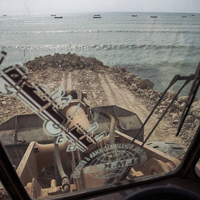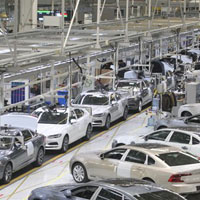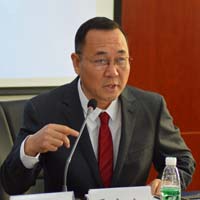-
黄仁伟:中国不会走历史上大国崛起的老路
专家简介黄仁伟,全球化智库(CCG)学术委员会专家,上海社会科学院副院长。 有人从历史经验的角度出发,担心中国的崛起会走德国、日本等国的老路。对此,黄仁伟给出了明确否定的回答:中国不会走这个老路。为什么?因为中国有中国智慧。 黄仁伟指出,权力转移不完全是军事力量和经济力量的转移,最终其实是思想、观念、制度等软实力的转移,这是最深刻的权力转移,也是非常艰难的。而中国智慧则为中国方案提供了有力支撑。 黄仁伟认为,要从中庸之道和渐进哲学来认识中国文化。中国文化主张量力而行,不主张一家包打天下。“一带一路”早期收获项目实际上都是同当地国家具体工程结合的,随着“一带一路”项目越来越多落地,它们就会连成片、连成线,最后连成网。可以说,和当地项目的结合是“一带一路”成功的路径。 有人担心,中国会不会用“一带一路”强迫别人做什么?黄仁伟表示,说这话的人其实不了解中国人际关系的哲学。中国人讲究两厢情愿,就是说双方都自愿做这个事,所以“一带一路”的所有项目一定是双方,或者是三方,甚至于四方互相情愿的事情,有一方不情愿,我们也不会做。如果更深入地了解中国的文化,就会知道我们倡导的是“己所不欲勿施于人”。他进一步从从秩序观的角度对此进行了阐述。现在大家都在讲全球治理,全球治理有多种模式,或者说多种理念。但是西方的全球治理就是要求各国接受西方的治理模式,也就是说设置了一个前提条件。但是中国的“一带一路”不设这种政治前提,没有这样的价值观预设。所以“一带一路”同当地的制度、文化是相结合的,以当地的制度和文化为主体,而不是试图改变当地的制度和文化,这是我们的一种秩序观。当然,“一带一路”在建设过程中,会面临一些风险,但应对这些风险要靠当地的国家和人民参与治理,而不是用中国的力量包下来。 黄仁伟认为,“一带一路”是一个包容、开放、多样性的发展过程。中国文化本身就是多样性的文化,世界上所有大国里面,中国文化的多样性是历史最悠久的,它是儒释道的结合,所以中国并不排斥任何文化,所谓“有容乃大”。这是中国文化的特征,我们在“一带一路”中同样要体现这种文化。 关于中国的天下观,黄仁伟也澄清了之前国际上一些人存在的误解,即认为中国的天下观是以中国为中心的天下。他指出,过去,确实是有这样的情况存在,清王朝就是一个典型。但是,在中国的天下观中还有另外一个层面,即以世界、以人类为己任,这样的天下观在现代的条件下,就变得比较先进了,比传统的盟国体系和势力范围等地缘政治理念要先进很多。“一带一路”建设中就充分体现了这种与世界同命运、共责任的天下观。他特别指出,中国的义利观超越了西方的狭隘利益观。“一带一路”不是一个施舍,它是按照市场的方式来运行的,目的要实现互利共赢。但是在运行中,我们先讲“义”再讲“利”,这也是“一带一路”可持续发展的支撑之一。 黄仁伟最后指出,中国历史文化中蕴含着很多智慧,值得深入挖掘和研究。在建设“一带一路”的过程中,一定要知己知彼,要知道各国的想法,也需要让各国知道中国的想法。文章选自上观新闻,2017年5月28日
2017年6月14日 -
CSOFT彭博社访谈:品牌、产品和运营如何“翻译”到全世界
理事简介叶雪泥,全球化智库(CCG)常务理事,华也国际信息咨询有限公司CEO。CSOFT华也国际创始人兼首席执行官葉雪泥(Shunee Yee)女士于6月7日上午接受了Bloomberg《彭博市场(亚洲)》的连线采访,分享其关于如何正确“翻译”(国际化)品牌、产品和运营的专业经验。■ CSOFT:“翻译界的 Uber ”进行采访的两位主播分别是来自香港的 Rish Salamat 和来自悉尼的 Haidi Lun,其中 Rish Salamat 刚刚采访了 Uber 首席执行官 Travis Kalanick。葉雪泥女士认为,CSOFT 也可被视为“翻译界的 Uber”,她解释道,现在全世界能够掌握两种以上语言的人数超过总人口的 50%,只要充分挖掘这一专业技能资源,结合现代科技,就可以做到让全世界的人都能够随时随地获得在线翻译服务。■ 企业国际化之未来趋势葉雪泥还提到,“只有大型跨国企业才能在全球扩展业务的时代已经成为过去。伴随着现代科技与互联网经济的高速发展,来自世界上任何地方、任何规模的企业都能够参与到国际市场竞争中来。正因为如此,更多企业的全球化进程也势必加速产生海量的翻译需求。”根据华也国际有关分析,相对于多数老牌500强企业在上世纪 80、90 年代立足于成熟市场所进行的国际化,目前正在进军全球市场的中国企业面临的挑战已不同于以往。除了要克服技术、语言和文化障碍,中国企业现在还面临着更为复杂的政治和地缘经济环境。最重要的是,数字经济的革命要求现代的产品和信息必须能够极速抵达全球用户。彭博社北京、香港、悉尼现场连线https://www.bloomberg.com/news/videos/2017-06-07/how-csoft-translates-products-and-operations-video (彭博社报道)华也国际是全球领先的本地化和全球化服务供应商,为全世界各个国家的企业和组织在开拓海外市场的过程中所遇到的跨语言、跨文化沟通相关的问题与挑战提供专家级解决方案。如果您想了解关于CSOFT的更多信息,请发送电子邮件至: info@csoftintl.com 或访问网址: www.csoftintl.com文章选自CSOFT,2017年6月13日
2017年6月14日 -

【Bloomberg】Chinese Firms Wary of Political Risks on Belt and Road
As the global limelight fades from President Xi Jinping’s “Belt and Road” summit, the main actors -- Chinese state-owned companies -- are warning about the political risks they face along the route.Earlier this month Xi outlined plans to direct as much as 840 billion yuan ($122 billion) to build roads, railways, ports and pipelines across Asia and beyond, securing China’s central role in world trade. The plan has the country’s state-owned enterprises weighing investments in 65 participant nations, almost two-thirds of which have sovereign debt ratings below investment grade.“Chinese companies’ risk awareness has grown, but they still lack the ability to discern where to invest or effectively manage overseas risks,” said Yin Yili, a vice president at a unit of China Communications Construction Co., one of the nation’s largest state-owned companies. “Over these past years, we’ve paid a great price and suffered big losses. We’ve paid a large amount in tuition fees.”The concerns highlight a major challenge of Xi’s signature trade-and-foreign-policy initiative: Ensuring that state companies don’t become overexposed abroad at a time when they are struggling to shed costs and slash soaring debt loads at home. State-owned companies had already insured more than $400 billion in projects in the four years before Xi’s summit.Some 71 percent of Chinese companies said political risk topped their concerns about investing abroad, according to a survey of 300 firms published in November by the Center for China and Globalization (CCG), a Beijing-based research institution. They cited “policy changes,” “political unrest” and “government expropriation” as top worries.Yin, who heads the industrial parks department at CCCC’s Industrial Investment Holding Co., said that almost two decades of foreign investment experience hasn’t necessarily translated into enhanced risk-control procedures for Chinese companies. Many still lack vision, negotiation skills and local knowledge, he said, adding that they sometimes assume money can solve all problems.“A lot of times they only see a bevy of opportunities, but not pitfalls underfoot,” Yin said. “There are more than 200 countries and regions in the world, and not every place is worth investment.”Protests, VolatilityThe Belt and Road route includes volatile areas like Afghanistan and Pakistan, as well as Iraq, Syria and Yemen. African countries including Egypt, Kenya and South Africa are also on the list and scrambling to expand ties with China. Ethiopian Airlines Enterprise on Monday launched its fourth route to the country.In 2014, protests over China’s oil-exploration in the South China Sea forced electronics maker Midea Group Co. to withdraw investment from neighboring Vietnam, which is part of the Belt and Road Initiative. China’s $1.5 billion Colombo Port City project in Sri Lanka has been dogged by demonstrations and briefly halted in 2015 after a new government pledged to review all deals by the previous Beijing-friendly administration.Concerns about political risk were scarcely mentioned as Xi hosted almost 30 world leaders in Beijing on May 14-15. The president’s keynote address only referenced the need to manage broad financial risks, while the chairman of China’s State-owned Assets Supervision and Administration Commission told reporters that political and security threats were “completely controllable.”‘Unstable Governments’“China needs to not only worry about walking into political traps leading to investment loss, but also worry about security of staff and assets,” said Raffaello Pantucci, director of international security studies at the Royal United Services Institute. “You are looking at parts of the world where you have politically risky and unstable governments, a variety of security threats, and a government in Beijing which has little clear skill or experience in managing these problems.”Risks were building long before Xi first outlined in 2013 the plan to recreate ancient Silk Road trading routes between Asia and Europe by land and sea. Beijing has been encouraging state companies to “go out” since the late 1990s, with much of that investment going toward oil and other raw materials in countries such as Venezuela, where slumping commodity prices have helped weaken the Beijing-friendly government.More than $250 billion in China’s overseas investments failed between 2005 and 2015, according to the China Global Investment Tracker, a database maintained by the American Enterprise Institute and the Heritage Foundation. The Center for China and Globalization, which separately analyzed 120 unsuccessful investments, found that political factors accounted for a quarter of all cases.Risk InsuranceSuch overseas investments are insured by the state-owned China Export & Credit Insurance Corp., or Sinosure, which covers government seizures, nationalization, political violence, contract breaches and payment delays because of political events. In an article published on the company’s website this month, Chairman Wang Yi described Sinosure as the Belt and Road Initiative’s “chief brake.”Since 2013, Sinosure insured $440 billion of exports and investments in Belt and Road countries and paid out $1.7 billion in claims, Wang wrote. Projects insured included a 1,800 kilometer (1,100 mile) pipeline to Turkmenistan, a $1.6 billion power plant in Jordan and an $800 million dam in Cambodia.Yuan Li, chairman of China Civil Engineering Construction Corp., which has more than 50 projects in Africa, said Sinosure’s insurance covers “extreme circumstances” like coups and war, but not normal political reversals.“There is a change of government almost every month,” Yuan said by phone. “There is no insurance on the earth catering to that. Our policy is to make friends as widely as possible, and not to get closer to any one party than the others.”Political concerns have led China’s state companies to steer clear of some markets. Gordon Li, the overseas business director for China Merchants Group’s international business department, said the company hasn’t considered adding India to the 48 port projects it’s financing in 18 Belt and Road countries.“For us, the No. 1 consideration is political risk,” Li said. “It’s extremely important whether the destination countries have good relations with China or not.” (By Ting Shi)From Bloomberg, May, 2017
2017年6月14日 -

【Global Times】US aims to curb deficit with China
Vehicles to be exported to the US at a factory in Daqing, Northeast China’s Heilongjiang Province on April 12 Photo: CFPThe US has noticed China’s recent increase in its foreign exchange reserves and its support for a strong yuan, and instead of labeling China a currency manipulator, the US will work harder to bring down its trade deficit with the world’s second-largest economy, experts said on Thursday. The comments were made after US Treasury Secretary Steven Mnuchin confirmed that the Bilateral Investment Treaty (BIT) between China and the US is on US President Donald Trump’s agenda, the Wall Street Journal reported on Wednesday. He noted at an event held at the US-China Business Council in Washington on Tuesday (US time) that the Trump administration aims to prioritize specific trade issues, according to the report.The US is focusing now on reducing its trade deficit with China rather than concerning itself with China’s intervention in the foreign exchange market, as Trump’s "America First" approach aims to enhance the competitiveness of US products, Bai Ming, a research fellow at the Chinese Academy of International Trade and Economic Cooperation, told the Global Times on Thursday. "Addressing the tremendous trade deficit with China and creating more opportunities for US companies are the key tasks now," he said. Bilateral trade between China and the US grew 21.1 percent year-on-year in May to 333.13 billion yuan ($49 billion), according to data released by the General Administration of Customs of China on Thursday. Within that amount, China’s exports to the US surged 18.3 percent year-on-year to 242.26 billion yuan, while imports from the US increased 28.5 percent year-on-year to 90.87 billion yuan, the data showed. China still has the largest trading surplus of all the US’ trading partners, according to the US Treasury report published in April. The US had a total trade deficit with China of $347 billion in 2016, the data showed. Upcoming dialogueTrade-related issues including the BIT will be highlighted at the upcoming comprehensive economic dialogue this summer, as protectionism has been rising in the US, Han Bing, an expert at the Institute of World Economics and Politics at the Chinese Academy of Social Sciences, told the Global Times on Thursday. In May, China and the US announced the initial results of the 100-day plan for trade talks, covering agriculture, financial services, investment and energy. Most of the agreements are expected to be implemented by July 16. "One of the highlights in the annual work report published by the office of the US Trade Representative (USTR) this year is to facilitate market access for American products in developing countries," Han said, noting that the BIT negotiations will focus on lowering investment barriers under the current negative list structure. The Trump administration is expected to take a more aggressive approach to ensure that more markets are truly open to US products and services. The US-China BIT, which had gone through 24 rounds of negotiations as of June 2016, is designed to address some of the major trade obstacles, according to a study published by the US-China Economic and Security Review Commission in August 2016. The potential benefits of a US-China BIT include increased bilateral investment, a leveled playing field, increased market access and further liberalized trade and investment, the study noted. Although the US will no longer accuse China of being a currency manipulator, given its stable foreign exchange moves, obstacles still remain, Bai noted. "The US has not given up on tying to impose high tariffs on some Chinese products," he said. On February 2, the US Department of Commerce announced it would impose anti-dumping duties from 63.86 percent to 76.64 percent and anti-subsidy duties from 75.6 percent to 190.71 percent on Chinese stainless steel sheet and strip imports. "These trade frictions are unlikely to disappear soon. But if there is no compromise on trade disputes, there will be little progress on the investment treaty," Bai added.The core of the upcoming dialogue between the two countries is trade and foreign exchange rates, and China aims to expand agriculture, high-tech and services imports from the US by maintaining stable exchange rates, Huang Jianhui, senior non-resident fellow at the Center for China and Globalization(CCG), a Beijing-based independent think tank, told the Global Times on Thursday. "The US will use tariffs as a bargaining chip to reduce its trade deficit," Huang said, noting that the US will also urge China to be more open to services trade and will try to push agriculture and liquid natural gas exports to China. (By Chen Qingqing)From Global Times,2017-6-8
2017年6月13日 -

【China Daily】China defines new globalization with its characteristics
President Xi Jinping, foreign delegation heads and guests pose for a group photo at the Leaders’ Roundtable Summit of the Belt and Road Forum for International Cooperation at Yanqi Lake International Convention Center in Beijing, May 15, 2017. [Photo/Xinhua]When I first coined the term "Chiglobalization" in 2009, it was a visionary concept inspired by Niall Ferguson’s concepts of UK-led Anglobalization and US-led Ameriglobalization along with the successful 2008 Beijing Olympic Games. Eight years later, the concept of China-initiated globalization is materializing, and the definition is more valid and reliable than before.The concept captures exactly what China’s leadership has been doing since 2013, particularly with the vision of Chinese dream and the Belt and Road Initiative President Xi Jinping proposed.Back then, I defined Chiglobalization as "the increasing global relevance, global presence, global influence, and global leadership of China in generating a fresh global vision for humanity, in creating a new model for economic development, in forging an alternative model of global and domestic governance, in creating a new model for science and technology development, and in creating a truly cosmopolitan culture characterized by multiculturalism, interculturalism and pragmatism."Chiglobalziation also suggested that it "refers to a process of China-led global search for and a global enlightenment by an alternative mode of life for humanity on the basis of, but above and beyond, the Eurocentric model," or the Anglo/American-centric model, for that matter.Consumer goods exported to all over the world helped deepen China’s global relevance and defined her global presence as a world factory after the country joined the World Trade Organization in 2001. More than 500 Confucius Institutes and 1000 Confucius Classrooms spread out among some 130 countries/regions put "Cultural China" on the world stage engaging in face-to-face dialogue with the world.China’s initial effort to exercise global influence is subsequently solidified by the recent exponential growth of her outbound economic clout. China is conservatively reported as the world’s second largest economy. With $4 trillion of foreign currency savings and domestic savings of 155 trillion yuan, equivalent of more than $22 trillion, China has been feverishly seeking in recent years to buy up properties and invest for corporate mergers and acquisitions around the world.With a total of $1 trillion FDI, China has directly invested more than $150 billion around the world, second only to the US and around 10 percent of the total global FDI amount in 2015 alone. This is coupled with growing numbers of outgoing Chinese tourists who spend $1 trillion on their foreign tours around the world.Take China’s influence in the US, for example. While Chimerica was coined to describe the growing economic interdependence between the US and China, "Chinafornia" is used to illustrate this roaring dynamism: As an epicenter of the national trend, "Chinafornia is the fluid ecosystem of entrepreneurs, students, investors, immigrants, and ideas bouncing back and forth between the Golden State and the Middle Kingdom."Moreover, discussions between the US and China are reportedly underway for China to invest in President Donald Trump’s $1 trillion plans for infrastructure improvements across the country, likely part of China’s Belt and Road Initiative. China’s power in national defense, global influence and the cultural industry is narrowing the gap with the US. Yanzhong Huang, a fellow on the Council of Foreign Relations, concludes that China is a superpower, but not yet a global leader.Perhaps it’s more accurate to say that China is on the path towards global leadership. Belt and Road Initiative, proposed by Chinese President Xi Jinping in 2013, is a plan to invest $1 trillion as seed money and attract an additional $9 trillion for infrastructure construction around the world, particularly Asia. This can be interpreted as a game-changing exercise of China’s global leadership, riding on a new wave of globalization with an aim of engineering better global governance. President Xi expressed such aspirations in keynote addresses at the World Economic Forum in Davos and at Europe’s UN Headquarters in Geneva.China has a core strategy. Instead of building military bases around the world like the US, China is relying on comprehensive strategies of communication and connectivity ranging from politics to finance, from infrastructure and trade to culture and religion to construct zones of economic cooperation and centers of cultural exchanges.President Xi and President Trump may have ironed out an elite international design to facilitate dialogue and negotiations over US-China relations, the Asia-Pacific and global affairs at the Mar-a-Lago Resort in April, and the Belt & Road Forum might be viewed as more of a mid-level design to establish a global dialogical structure with middle and small powers for co-development and co-security. Such a two-tiered structure is indicative of and facilitates formation of a new global culture – a world community of a shared future.Based upon the strengths of its predecessors such as the neoliberal world order, Chiglobalization could define and sustain a new wave of globalization and global governance with the Chinese accent in the 21st century as more benign, both more equal and equitable, more open and pluralistic, more peaceful and harmonious than its predecessors.Given China’s core value of groupism, Chiglobalization coincides with multilateralism, a kind of co-globalization, and even Chiglocalization – encompassing re-modernization and re-globalization in the form of infrastructure improvements for developed countries and brand-new modernization for developing countries.Globalization has no endpoint and it cannot afford homogeneity either. Chiglobalization, like its predecessors, is making the phenomenon full, less partial and homogenous, and more diverse. Every nation should have a chance to ride this new wave of globalization.Western leaders, including former President Barack Obama, and mainstream American media have criticized China for being a free rider in global governance. But now China is taking up the Belt and Road initiative, a new global public good to sustain globalization and global governance.The Western world, particularly the United States, should have welcomed this initiative. In the meantime, China learned a lesson from the negative experience of rejecting Anglobalization and Ameriglobalization and the positive experience of embracing them later on.About Author Jia Wenshan, an academic advisor of the Center for China and Globalization(CCG), and a professor with the School of Communication, Chapman University.From China Daily, 2017-6-8
2017年6月13日 -
金灿荣:中国不存在懈怠问题,会一直向前走
金灿荣,CCG学术委员会专家、中国人民大学国际关系学院副院长。人类命运共同体的提出表明中国承担起更多国际责任 习近平主席在上任伊始就提出“中国梦”。当时的西班牙首相索拉纳就讲,习主席提出“中国梦”,其实是大国宣言。从外交的角度看,中国发展到了一个需要在世界上发声的阶段。最近出现频率很高的三个词,即全球伙伴关系网络、合作共赢的新型国际关系、人类命运共同体。这三个词语是有内在联系的。如果国与国之间能够结成伙伴关系网络,那么就可能走向合作共赢的新型国际关系,然后才能达致最终目标——人类命运共同体。 另一方面,人类命运共同体的提出是对现行国际体系的完善。现行国际体系是由西方国家主导建立的,我们应该看到它的历史贡献。西方国家率先从农业文明进入工业文明,实现了生产力的大发展,使人类征服自然、改造自然的能力大大提升,这是值得肯定的。但现行国际体系有其根本不平衡的方面。二战之前国家就分为列强、殖民国家、殖民地国家。二战后,虽然很多殖民地国家纷纷实现民族独立,但国际体系根本上是不平等的。国际关系还陷在零和游戏、国强必霸的逻辑中。现在,人类命运共同体的提出,将会推动国际体系向更公正、合理的方向发展。中国坚定推进经济全球化给世界吃了定心丸 全球化的进程从地理大发现时就开始了,是人类走向统一生活方式的一个过程。全球化最高峰是在过去的30年。全球化凯歌行进30年后,逐渐有一些问题暴露出来,比较突出的是金融力量太强大、实业被压缩,形成巨大泡沫,这是很危险的。各国内部出现了贫富分化,国家间的发展也出现分化,人们的观念混乱,对前途没有把握、缺少信心。这些年,在全球化的发源地——英美国家出现了逆全球化的思潮和现象。2016年英国脱欧,还有美国特朗普成功竞选总统,我认为是他们本国的民众对过去30年全球化成果分配不满意的结果。 美国总统特朗普就职后,其废除TPP、退出《巴黎协定》等一系列举动,令许多国家不安,全球化以往的推动力量——美国改变了对全球化的态度,不禁让人对全球化的未来十分担忧。特别是那些靠贸易生存的小国家,比如新加坡、阿联酋、荷兰、日本、韩国等,它们更是忧虑。这种情况下,他们期待中国能发挥更大作用。今年1月,习近平主席在达沃斯世界经济论坛上的一番讲话,得到了国际社会的一片掌声,原因是什么?在这种全球化前途不明的情况下,中国作为世界上GDP排位第二的国家、第一大货物贸易出口国、第一大制造业国家,决定继续推进全球贸易自由化,支持经济全球化。这就给世界提供了信心,让世界吃了一颗定心丸。中国不存在中等收入陷阱 现在很多人在谈两个陷阱,国内的叫中等收入陷阱,国际上叫修昔底德陷阱。我个人认为东亚国家不存在中等收入陷阱,那其实是个拉美现象。我比一般学者更有信心是因为,我的研究表明:现代文明的基础是现代制造业,中国恰恰具备了独立掌握现代制造业的能力。这是我对中国充满信心的重要来源。 信心的另一个来源是,中国的纠错能力非常强,我们不存在懈怠的问题,我们会一直向前走的。任何国家在发展过程中很难保证绝不犯错误,国家间长期竞赛比的就是纠错能力。中国人在纠错和前进上的能力和愿望是非常强的。这也是我对中国充满信心的来源所在。文章选自人民网,2017年6月8日
2017年6月13日 -
龙永图:产能合作将为一带一路沿线国家带来大量就业及税收
中国与一带一路沿线国家的产能合作,首先会给他们带来大量的就业,美国的研究报告讲,在基础设施和产能合作方面,我投资10亿美元,大概可以创造12000到23000个就业岗位,另外就是给他们带来多少的税收,23亿这个税收。理事简介龙永图,CCG联席主席,原外经贸部副部长,原博鳌亚洲论坛秘书长。 我觉得在谈中国的企业通过一带一路框架之下的产能合作怎么样的经营,我觉得谈经营的时候,首先要谈到我们,我们做这个事情别人会有什么意义,我觉得这样的一种合作模式就很难持久。所以在谈中国产能合作的时候,中国一带一路沿线国家产能合作的时候,我们要考虑这样的产能合作能给对方带来什么,然后再谈我们能有什么。 首先我觉得我们国家一带一路沿线国家的产能合作,首先给他们带来大量的就业,美国的研究报告讲,在基础设施和产能合作方面,我投资10亿美元,大概可以创造12000到23000个就业岗位,另外就是给他们带来多少的税收,23亿这个税收。 第二个好处,就是怎么样通过产能合作,改变或者调整这些国家的经济结构。前天我和马来西亚的部长会在论坛对话的时候,我们马来西亚的贸易产生断崖式的下跌,他们主要是靠出口石油,农产品,包括天然橡胶、棕榈油,一旦这些产品国际价格大幅度的下降,他的国际贸易就崩溃。所以我们要调整我们的思路。 所以我们在一带一路框架之下,我们和他们搞产能合作的时候,首先要看这种合作能不能给对方带来政府税收,能不能促进他们经济和贸易的优化,如果能做到这一点,我们就合作,因为不考虑对方的利益,我们从我们自己的利益来考虑合作的话,那么很难成功,而且可能带来很大的负面影响。如果我们考虑这些因素以后,我们产能合作当中,我们就可以考虑中国企业可以得到什么机会,我们中国企业可能得到什么利益。第一个就是我们中国可能需要短缺的资源,一带一路沿线国家数量很大,在进行一带一路峰会的时候,印度尼西亚的一个商会副会长他就说,我们印度尼西亚的镍矿占世界的70%,希望中国可以去开发。第二个,我们可以赢得巨大的市场,我们中国市场很大,但是还是出现了产能过剩,所以市场还是需要开拓,我们要寻找新的市场,开拓新的市场。现在提供了一个开拓新市场的巨大空间,我遇到一个巴基斯坦的官员就说,他说你们来巴基斯坦投资,我们35%以上的人口,我们35岁以下的人口大概占我们人口比例60%,我们有一亿2000万的巴基斯坦人用手机,有5000万人用互联网,所以我觉得投资的机遇和成功的可能性是很大的,关键在于我们怎么样确定好一些项目,而且在我们加快进程的情况下,可以顺畅起来。 我回答你的问题,考虑到中国和一带一路沿线国家产能合作的时候,第一首先要考虑对方的利益,使我们合作的项目能够满足这些利益。 第二,我们中国确实有我们自己的利益,不是说我们中国搞一带一路,是当冤大头,不是这样子。我觉得这一点中国不管从利用国际视野,和开拓国际市场方面,我认为中国都会有巨大的机会。文章选自中国经营网,2017年6月8日
2017年6月13日